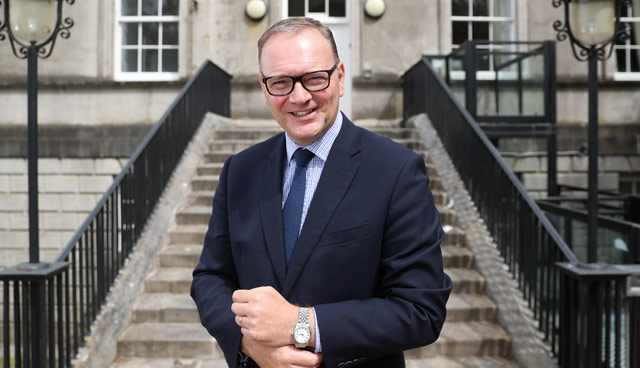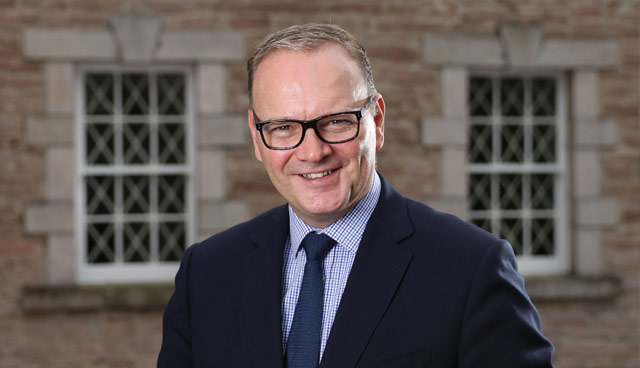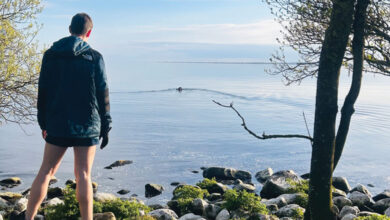A catalyst for growth

Chief Executive of Northern Ireland’s second largest Council, Armagh City, Banbridge and Craigavon Borough Council, Roger Wilson, believes that the area’s solid strengths and its increasing potential across a number of areas could be better leveraged to stimulate wider economic growth across Northern Ireland.
Now in his fourth year since taking up post as Chief Executive of the then newly formed Armagh City, Banbridge and Craigavon Borough Council, Wilson assesses that the initial preparation through to operation of the local authority has been successful, laying the foundations for ambitious economic and social growth in the Borough. Economically, that opportunity can be recognised in the fact that Armagh, Banbridge and Craigavon accounts for 10 per cent of Northern Ireland’s total GVA, with an economy of over £3 billion. Its 123,000 strong workforce serves some of Northern Ireland’s largest businesses and the local economy is underpinned by some 8,000 small-to-medium-sized businesses (SMEs). The Borough is home to some of Northern Ireland’s greatest success stories including Moy Park, Almac, Thompson Aero seating, Irwins, Whites, Hyster Yale and Tayto to name a few.
Wilson is well aware, however, that the political context in which his tenure began and the one that exists now is somewhat different, creating an ever changing landscape from which to reach those ambitious goals.
While the absence of Stormont has had some impact on the immediate operations of local government, Wilson appreciates that in the longer term this will have more significant challenges.
“Day-to-day Council operations are running as they should; but where the challenge exists is around delivery of our larger projects, such as town and village investment or major infrastructure schemes, where Ministerial decisions are required,” he says.
“We recognise that our ambitious plans for the Borough are not done in isolation. They are done in partnership with central government and with the support of other stakeholders. Anything limiting this approach will have an impact on us.
“My concern at the minute is that although there are reassurances that plans are not lying dormant and are being progressed through the pipeline to await ministerial sign-off, there is very little being requested for input into the pipeline. In the near future this will create a lag and potentially missed opportunities for economic and societal development across our borough and Northern Ireland.”
On taking up the role, Wilson recognised that a major job of work would be ensuring that the economic potential of Armagh City, Banbridge and Craigavon Borough Council, as Northern Ireland’s second largest council area, is fully recognised at a regional level.
His job was helped somewhat by the change in attitude which resulted from the reform of local government. As explained by Wilson, with the changes came a consensus at local political level for a greater focus on improvements in areas such as the economy, the social agenda and community planning.
He outlines: “The new Council has a new attitude. I believe that everyone has recognised the wider responsibility associated with serving more people within a larger geographic area. With a bigger budget and increased powers comes greater opportunity, both for change within the area and Northern-Ireland wide.” Four years in, Wilson believes that Councils should now have additional powers transferred to them, especially in the absence of a functioning Executive.
Innovation and investment
Wilson assesses the local economy as “buoyant”, with a positive short-to-medium-term outlook. This, he highlights, is reinforced by the significant capital investment programme that the Council is delivering. Indicators of success are the planned development of a £35 million leisure centre in Craigavon, a £30 million leisure village in Armagh, and multi-million investment by the Southern Regional College across a number of campuses in the borough. Commercially, the private sector is performing well with new investments daily across a range of sectors.
The Borough has carved a name for itself as a hub for the life sciences and advanced manufacturing sectors, as well as a mainstay of the agri-food sector, achieving the title of the ‘Food Heartland of Northern Ireland’.
Describing the Borough as “vibrant, with a strong international focus and wealth of exporting knowledge, as well as being open for a business on a global scale”, Wilson outlines the ambitions not just to attract greater levels of foreign direct investment (FDI) to the area, but also to further proactively foster and support the growth of innovative SMEs, which he describes as the “backbone” of the local economy.
“We are too small of a region to be competitive with one another and instead need to ensure that the local actions we take can be beneficial to the sum.”
Quizzed on whether this would see the Borough aim to be more directly competitive with Belfast, he explains: “In my opinion a strong capital city is good for Northern Ireland as a whole. It’s very much a rising tide and I see a strong Belfast as being beneficial to our Borough and beyond. It allows us to raise our game. By the same means, we see a strong borough as being complementary to Belfast and Northern Ireland plc.
“We are too small of a region to be competitive with one another and instead need to ensure that the local actions we take can be beneficial to the sum. All of us must play to our strengths. One of the advantages of local government reform was that we now have a group of chief executives who meet more regularly and enjoy meaningful constructive engagement on strategic issues.
“In the absence of an Assembly, we are the only democratically-elected government organisations at the minute, so it’s important that the Councils show leadership and put Northern Ireland’s best foot forward.”
Connected
A major selling point of the Borough is its proximity and ease of access to Ireland’s two largest cities, Belfast and Dublin, while still being far enough away to enjoy the merits of more affordable housing, competitive operating costs and good infrastructure connectivity.
Wilson states: “With significant land zoned for economic development, a number of existing enterprise areas and our strategic location on the Belfast-Dublin and Belfast-Enniskillen economic corridors, we are ideally located for both inward investment and indigenous business growth. Take for example Banbridge’s close proximity to both Belfast and Dublin with a strong transport infrastructure, lower operating costs and outstanding quality of life. This makes it an ideal location for any investor looking to relocate and serve northern and southern markets.
“Tie that in with the fact that we are officially Northern Ireland’s best place to live and work with affordable housing, low commuting times, high employment, low crime rates, good schools and local services and you can see why so many of Northern Ireland’s largest employers have opted to base themselves here.
“Another reason is our solid skills base and robust research and development focus, with an extensive skills and apprenticeships provision. However, it’s not just the case where we tailor to these large companies. Our Collaborative Growth Programme provides support for groups of SMEs who want to work together to scope and exploit opportunities that could enhance their competitive edge. In growing and supporting our indigenous businesses, we ensure the longer-term sustainability of our economy and society.”
Wilson stresses that there is a mutual benefit in supporting local businesses to access global markets. Recently the Council brought delegations to India and America as part of their ‘Go East’ and ‘Go West’ investment programmes. “For many of the businesses accessing information on raw materials, exploring export channels and making business connections was invaluable. But it also presented a fantastic opportunity for us to raise our profile with key decision makers,” he adds.
Clusters and growth sectors
Addressing the emerging economic clusters that now exist in the Borough and the potential areas for growth, Wilson points to the recently developed strategy and delivery plan around advanced manufacturing as a prime example of how the Council can play a role in facilitating growth.
“Our role is facilitative and our actions constructive. We can help in building relationships for the benefit of all parties and we can improve communications significantly. Advanced manufacturing is a huge sector but we recognise that within it there are many facets where we can assist, such as signposting around energy, skills or education. We can act as a reference point, making connections for businesses in this sector, both big and small.”
The digital economy is another sector where Wilson has identified space for growth. However, he is also keen to ensure that any investment is proportionate to demand. Northern Ireland as a whole enjoys direct connectivity to North America through Project Kelvin. As well as this, its digital network provides high-speed voice and data connections throughout the world, ranking as the best in the UK for superfast broadband ability.
Wilson says: “For this reason, the Council has commissioned extensive research into the suitability of creating further DigiHubs within the Borough. It’s something that is being considered and could be complemented by the significant land zoned for economic development which we hold. However, as highlighted previously, we’re keen to ensure that the economic investments we make are robust and ensure the best outcomes for the Borough and for Northern Ireland plc.” Council have also recently appointed a digital ambassador to actively promote the area’s growing digital sector.
“With a bigger budget and increased powers comes greater opportunity, both for change within the area and Northern-Ireland wide.”
The Chief Executive points to the tourism sector as another area of significant growth potential and his desire to “get the region on the map”. Attributes such as Armagh being Ireland’s oldest city, it being the ecclesiastical capital of Ireland and home to St Patrick’s first founded church (St Patrick’s Anglican Cathedral), are well known locally but less well known on a wider scale. Wilson sees greater potential in infusing these attributes with other successes in the sector, such as the successful participation by the Council in Northern Ireland’s ‘Year of Food and Drink’, to ensure a world-class proposition exists for people to visit.
Again, he highlights the facilitation role that Council can play in this. As well as investments that compliment growth on council-owned facilities, he stresses the need to support local business in areas such as around technology and ensuring that everyone involved in the tourism sector fully appreciates and meets the standards expected by global visitors.
Challenges
Wilson accepts that plans for growth in the Borough are not without challenges. While he aims to promote the many attributes of the area, he stresses the need for acknowledgment and support from central government in recognising their ambitions.
“Infrastructure is a particular area where we would like to see greater levels of awareness from central government that we are the largest local authority after Belfast. While we enjoy good connectivity, there is an argument to be made to improve this further, such as extending the rail access to Armagh. If ambitions for overall economic growth across Northern Ireland is to be recognised then there must be the services available to meet the subsequent increase in levels of demand.
“However, our focus isn’t just on large-scale infrastructure improvement. Something we have been advocating for is a gateway project for the Borough, ensuring that it is visibly attractive and welcoming to all. It wouldn’t require a large investment but our challenge is getting the recognition that investment in such projects would be beneficial to the Borough, beneficial to surrounding councils and, overall, beneficial to Northern Ireland.
“Also, we want to see improvements in broadband for rural areas. While most of the Borough is well connected, there are many rural areas where connectivity is very poor. We want to ensure that when attracting or fostering businesses, the whole of the Borough has equal opportunity and make sure that we are making the best use of our many assets.”
A universal challenge to all local authorities and indeed central government in Northern Ireland is that of Brexit. Wilson believes that once a greater level of clarity exists on the impact of Brexit, both the challenges and opportunities of the outcome must be assessed in equal measure.
“Currently, the role we are performing is that of assisting and supporting those businesses with their needs and ensuring that we have constant lines of communication to see where we can help address their issues.”
However, he adds: “We will continue to work with our neighbouring councils along the border corridor, having previously conducted research with Ulster University to understand the impact of Brexit for border communities”.
Concluding, Wilson outlines his hope that following the local elections in May 2019, the Council can continue on its positive trajectory, building on the strong foundations that have been laid. “The Armagh City, Banbridge and Craigavon Borough Council area represents an excellent location in which to do business, to invest, visit, live and study. Building on the progress we’ve made in a few short years we’re already on a solid path to maximise our economic potential and to fully utilise our high quality assets to generate growth for everyone’s benefit.”






